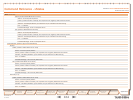
D 14049.01
07.2007
170
TANDBERG VIDEO COMMUNICATION SERVER
ADMINISTRATOR GUIDE
Text goes here
Introduction
Getting
Started
System
Overview
System
Configuration
H.323 & SIP
Configuration
Registration
Control
Zones and
Neighbors
Call
Processing
Firewall
Traversal
Bandwidth
Control
Maintenance
Appendices
TANDBERG VIDEO COMMUNICATION SERVER
ADMINISTRATOR GUIDE
Appendices
address-switch node
The address-switch node allows the script to run different actions based on the source or
destination aliases of the call. It specifies which fields to match and then a list of address nodes
contains the possible matches and their associated actions.
The address-switch has two node parameters: Field and Subfield.
address
The address construct is used within an address-switch to specify addresses to match. It supports
the use of Regular Expressions (see Regular Expression Reference for further information).
is=string
Selected field and subfield exactly match the given string.
contains=string Selected field and subfield contain the given string.
Note: The CPL standard only allows for this matching on the
display subfield; however the VCS allows it on any type of
field.
subdomain-of=string If the selected field is numeric (e.g. the tel subfield)
then this matches as a prefix; so address subdomain-
of=”555” matches 5556734 etc.
If the field is not numeric then normal domain name
matching is applied; so address subdomain-
of=”company.com” matches nodeA.company.com etc.
regex=”regular expression” Selected field and subfield match the given regular
expression.
All address comparisons ignore upper/lower case differences so address is=”Fred” will also
match fred, freD etc.
CPL Reference
This Appendix gives details of the VCS’s implementation of the CPL language and should be read
in conjunction with the CPL standard RFC 3880 (5).
The VCS supports most of the CPL standard along with some TANDBERG-defined extensions. It
does not support the top level actions <incoming> and <outgoing> as described in RFC
3880. Instead it supports a single section of CPL within a <routed> section.
When Administrator Policy is implemented by uploading a CPL script to the VCS, the script is
checked against an XML schema to verify the syntax. There are two schemas - one for the basic
CPL specification and one for the TANDBERG extensions. Both these schemas can be viewed
from the web interface. and used to validate your script before uploading to the VCS.
The following example shows the correct use of namespaces to make the syntax acceptable:
<?xml version=”1.0” encoding=”UTF-8” ?>
<cpl xmlns=”urn:ietf:params:xml:ns:cpl”
xmlns:taa=”http://www.tandberg.net/cpl-extensions”
xmlns:xsi=”http://www.w3.org/2001/XMLSchema-instance”
xsi:schemaLocation=”urn:ietf:params:xml:ns:cpl cpl.xsd”>
<taa:routed>
<address-switch field=”destination”>
<address is=”reception@example.com”>
<proxy/>
</address>
</address-switch>
</taa:routed>
</cpl>
otherwise node
The otherwise node will be executed if the address specified in the address-switch was found
but none of the preceding address nodes matched.
not-present node
The not-present node is executed when the address specified in the address-switch was not
present in the call setup message. This form is most useful when authentication is being used.
With authentication enabled the VCS will only use authenticated aliases when running policy so
the not-present action can be used to take appropriate action when a call is received from an
unauthenticated user (see the example call screening of unauthenticated users).
Overview


















